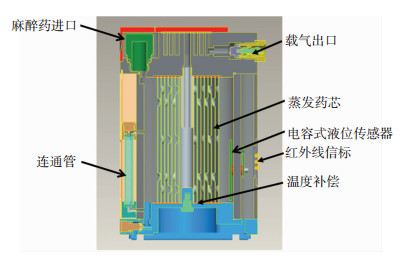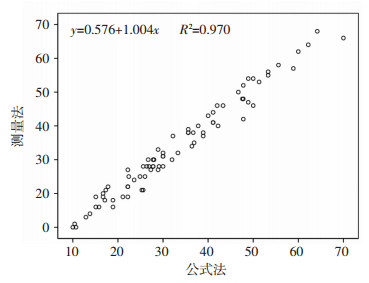由于七氟烷具有血气分配系数低,呼吸道刺激性小,对血流动力学影响小等诸多优点,为目前全世界麻醉医生最广泛采用的吸入麻醉剂[1]。传统挥发罐仅设有联通管标定麻醉药物剩余量大致位置,医务人员不便获知初始加入的液态七氟烷体积、剩余液态七氟烷的实时体积、液态七氟烷的使用速度及液态七氟烷的续航时间。传统挥发罐使用称重法,依靠前后挥发罐的质量差值来测算消耗液态七氟烷的体积,被公认为金标准方法,但这种方法对称量设备要求较高且操作复杂,在临床实践中并不实用[2]。通常患者所用挥发性麻醉药的收费,常规依靠公式法推算出,该公式根据称重法得出,但对于术中无法恒定吸入浓度的病例并不实用,造成医疗资源的浪费[3-4]。挥发罐的智能化是对老款麻醉机的升级,可以实现麻醉机整体目标靶控[5]。目前,国外挥发罐生产单位虽然开始重视挥发药药量自动监测的重要性,但是由于价格昂贵,仍不利于现阶段广泛推广。我科与企业共同研发的新型国产BR850电子挥发罐,通过整合电容式液位传感器对七氟烷在挥发罐内的液态余药量进行实时的监测[6-7],从而测算液态七氟烷的消耗量[8]。本研究在79例妇科腔镜手术患者麻醉中使用BR850七氟烷电子挥发罐,分别采用公式法、称重法、测量法计算术中消耗液态七氟烷的体积,以验证BR850电子挥发罐监测七氟烷消耗量的可行性。
1 资料与方法 1.1 一般资料选择2016年1月至2017年6月于本院行妇科腔镜手术患者,纳入标准:①年龄18~75岁;②拟行全身麻醉;③ASA Ⅰ~Ⅲ级;④患者自愿参加研究,并签署知情同意书。共纳入患者79例,年龄(42.28±12.49)岁,BMI为(22.38±3.53)kg/m2,麻醉时间为(149.29±63.27)min,消耗七氟烷质量为(51.61±21.96)g。本研究通过第三军医大学西南医院伦理委员会审批[2016年科研第(69)号]。
1.2 仪器设备Boaray700麻醉机(中国深圳市普博科技有限公司)上加载新型国产BR850电子挥发罐1套(图 1)。该款电子挥发罐由我科和企业合作研制,监测基本原理在于电容两极之间存在液态与气态两相电介质,液相和气相形成的电容各不相同,随着液面的变化,两相电介质在电容两极间的面积也随之改变,各自产生的电容发生改变,总电容也就发生了改变[9-10]。内部加装的整合电容式液位传感器通过罐内液面的变化推算出体积的消耗(图 2),另在罐口设有七氟烷浓度监测装置,反馈调节进入罐体的载气流量。

|
| 图 1 新型国产BR850电子挥发罐外观图 |

|
| 图 2 新型国产BR850电子挥发罐剖面图 |
1.3 方法 1.3.1 麻醉方法
诱导前更换螺纹管、二氧化碳吸附剂,常规检查调试麻醉机并确认无泄漏,称量开启之前挥发罐质量;安装挥发罐后,记录自动显示的开启挥发罐之前的液态七氟烷余药量。患者入室平卧,核对患者信息,开放静脉通道,常规监测无创血压、指尖脉搏氧饱和度、心电图、呼吸末二氧化碳、Nacotrend脑电监测仪(Blue sensor,Medicotest Olstykke, 丹麦)。全麻诱导静脉给予咪达唑仑0.04~0.05 mg/kg、枸橼酸舒芬太尼注射液0.5 μg/kg、依托咪酯0.3 mg/kg、阿曲库铵0.6 mg/kg,气管内插管后连接麻醉机回路。麻醉维持:术中恒定吸入纯氧2 L/min,避免使用快速充氧,设置挥发麻醉药药量监控系统吸入七氟烷浓度为2%,潮气量10 mL/kg,呼吸频率10~14次/min,维持呼吸末二氧化碳35~45 mmHg。复合恒速泵注盐酸瑞芬太尼0.25 μg/(kg·min)、丙泊酚[具体泵注速度根据Nacotrend参数调整,维持麻醉深度级别(narcotrend stage, NTS)在D2~ E1[11-12], 即麻醉深度指数(narcotrend index,NTI)在46~20],按需追加阿曲库铵[13]。术中采用补液、血管活性药物维持循环稳定,将血压波动幅度控制在入室血压的±20%以内。术毕停止吸入麻醉药,记录自动显示关闭挥发罐之后液态七氟烷余药量,称量关闭挥发罐之后质量。
1.3.2 七氟烷消耗量液态体积测算方法麻醉结束后采用三种方法测量同一名患者七氟烷使用量。
1.3.2.1 公式法消耗液态七氟烷体积(mL)=靶浓度×新鲜气体流量(mL/min)×靶浓度持续时间(min)/饱和蒸汽体积(mL/mL)。靶浓度为2 %(吸入七氟烷浓度恒定为2%),新鲜气流量术中恒定为2 000 mL/min (2 L/min),持续时间为手术时间(手术结束时间-手术开始时间),饱和蒸汽体积默认为180 mL。
1.3.2.2 称重法消耗七氟烷质量(g)=开启挥发罐之前质量-关闭挥发罐之后质量。室温下液态七氟烷密度为1.52 g/mL,消耗液态七氟烷体积(mL)=消耗液态七氟烷质量/1.52。
1.3.2.3 测量法消耗液态七氟烷体积(mL)=开启挥发罐之前的液态七氟烷余药量-关闭挥发罐之后的液态七氟烷余药量[14]。
1.4 统计学分析采用SPSS 19.0统计软件,计量资料以x±s表示,组间比较采用t检验,采用线性回归分析称重法与公式法、称重法与公式法、公式法与测量法的相关性,P < 0.05为差异有统计学意义。
2 结果 2.1 一般资料本组患者麻醉时间为(149.29±63.27)min,消耗七氟烷质量为(51.61±21.96)g。公式法、称重法、测量法测得液态七氟烷消耗量分别为(33.18±14.06)、(33.87±14.41)、(33.89±14.33)mL,公式法与称重法平均差值为(-0.70±2.28)mL。称重法与公式法、公式法与测量法、称重法与测量法比较,差异均无统计学意义(P > 0.05)。
2.2 3种方法的相关性分析用3种方法测算同一患者术中使用的液态七氟烷消耗量,线性回归分析结果显示:称重法与公式法测量七氟烷消耗量的决定系数R2为0.977(图 3),称重法与测量法计算七氟烷消耗量的决定系数R2为0.992(图 4),公式法与测量法计算七氟烷消耗量的决定系数R2为0.970(图 5),均具有良好的正相关性。

|
| 图 3 称重法与公式法测量七氟烷消耗量的线性回归分析 |

|
| 图 4 称重法与测量法测量七氟烷消耗量的线性回归分析 |

|
| 图 5 公式法与测量法测量七氟烷消耗量的线性回归分析 |
3 讨论
七氟烷是一种经典挥发麻醉剂,其挥发罐的作用不仅关系到病人吸入麻醉的效果,还直接涉及患者外科手术治疗的成败[15]。由于临床广泛采用七氟烷吸入麻醉,消耗量计算方法主要有两种(称重法与公式法),但是各有局限。称重法需拆下净质量超过6 500 g的挥发罐,采用高精度的称将质量精确到克,因此,该方法主要适用于科研。公式法由于麻醉医师在术中将随时调整吸入浓度、新鲜气流量等参数,加之饱和蒸汽体积会受到海拔与温度的影响等原因,使得计算复杂。文献[14]推荐刻度法,即将蒸发罐液面刻度每升高1 mm所需的吸入麻醉液体体积,乘以当次麻醉前后液面刻度变化值得出最终消耗量,但是不同挥发罐内部结构迥异,也不便于回顾性分析。
本课题组将电容式液位传感器整合进入挥发罐内部[15]。其优点为:传感器无机械可动部分,结构简单、可靠;精确度高;检测端消耗电能小,动态响应快;维护方便,寿命长。在微处理器中的麻醉药物初始体积运算模块进行处理,可计算出加入的挥发麻醉药物的初始液态体积,并在显示屏中显示,以使医务人员确切知晓加入的麻醉药物的体积。在对患者进行麻醉的过程中,通过液位的感知,可计算出挥发罐内剩余麻醉药物的体积,进而信息传输给显示屏,以使医务人员实时掌握挥发罐内的剩余药量体积[4, 16];同时,掌握了消耗速度,以避免患者麻醉过深,浪费麻醉药物[17]。本研究发现:体积智能化监测控制改进后,传统的药液挥发方式已无法完美的匹配,如在后期的型号中改用药仓贮存液态麻醉药便于质量监测。抽吸液态麻醉药喷洒入混合回路,既能通过测量方法由体积监测转为质量监测,进一步缩小用量误差,又能恒定麻醉气体浓度。本研究的局限性在于,采用3种方法均计算一种挥发罐自身的用药量,与其他型号挥发罐进行对比分析的研究有待进一步开展。
综上所述,BR850电子挥发罐监测液态七氟烷消耗量不受麻醉时间、大气压、温度等因素影响,也适合术中变化新鲜气流量与吸入浓度,能实时监测挥发罐消耗液态七氟烷体积[6, 19],其结果与称重法、公式法并无明显差异,该设备升级成本优势明显,便于临床、科研工作的开展,有利于吸入麻醉自动化闭环控制系统的实现[19-20],符合国际医疗设备自动化控制发展趋势,适于我国精准医疗的需求。
| [1] | DE HERT S, MOERMAN A. Sevoflurane[J]. F1000Res, 2015, 4(F1000 Faculty Rev): 626. DOI:10.12688/f1000research.6288.1 |
| [2] | ATHIRAMAN U, RAVISHANKAR M, JAHAGIRDHAR S. Performance of computer simulated inhalational anesthetic uptake model in comparison with real time isoflurane concentration[J]. J Clin Monit Comput, 2016, 30(6): 791–796. DOI:10.1007/s10877-015-9776-6 |
| [3] | DEHOUWER A, CARETTE R, DE RIDDER S, et al. Accuracy of inhaled agent usage displays of automated target control anesthesia machines[J]. J Clin Monit Comput, 2015, 30(5): 539–543. DOI:10.1007/s10877-015-9746-z |
| [4] | SHIN H W, YU H N, BAE G E, et al. The effect of fresh gas flow rate and type of anesthesia machine on time to reach target sevoflurane concentration[J]. BMC Anesthesiol, 2017, 17(1): 10. DOI:10.1186/s12871-016-0294-y |
| [5] | HARISSEH R, CHIARI P, VILLEDIEU C, et al. Cyclophilin D modulates the cardiac mitochondrial target of isoflurane, sevoflurane, and desflurane[J]. J Cardiovasc Pharmacol, 2017, 69(5): 326–334. DOI:10.1097/FJC.0000000000000479 |
| [6] | PHILIP J H. Using screen-based simulation of inhaled anaesthetic delivery to improve patient care[J]. Br J Anaesth, 2015, 115(Suppl 2): ii89–94. DOI:10.1093/bja/aev370 |
| [7] | AMIRAV I, LUDER A S, HALAMISH A, et al. Computerized dead-space volume measurement of face masks aplied to simulated faces[J]. Respir Care, 2015, 60(9): 1247–1251. DOI:10.4187/respcare.03813 |
| [8] | SKALEC T, GÓRECKA-DOLNY A, ZIELIŃSKI S, et al. Comparison of anaesthetic gas consumption and stability of anaesthesia using automatic and manual control over the course of anaesthesia[J]. Anaesthesiol Intensive Ther, 2017, 49(1): 34–39. DOI:10.5603/AIT.2017.0008 |
| [9] | SINGH P M, TRIKHA A, SINHA R, et al. Measurement of consumption of sevoflurane for short pediatric anesthetic procedures: Comparison between Dion's method and Dragger algorithm[J]. J Anaesthesiol Clin Pharmacol, 2013, 29(4): 516–520. DOI:10.4103/0970-9185.119160 |
| [10] | BIRO P. Calculation of volatile anaesthetics consumption from agent concentration and fresh gas flow[J]. Acta Anaesthesiol Scand, 2014, 58(8): 968–972. DOI:10.1111/aas.12374 |
| [11] | AMORNYOTIN S, CHALAYONNAWIN W, KONGPHLAY S. A randomized controlled trial of preprocedure administration of parecoxib for therapeutic endoscopic retrograde cholangiopancreatography[J]. J Pain Res, 2012, 5(default): 251. |
| [12] | DENNHARDT N, BOETHIG D, BECK C, et al. Optimization of initial propofol bolus dose for EEG Narcotrend Index-guided transition from sevoflurane induction to intravenous anesthesia in children[J]. Paediatr Anaesth, 2017, 27(4): 425–432. DOI:10.1111/pan.13118 |
| [13] | DUAN G, GUO S, ZHAN H, et al. A new real-time method for detecting the effect of fentanyl using the preoperative pressure pain threshold and Narcotrend index: a randomized study in female surgery patients[J]. Medicine (Baltimore), 2015, 94(1): e316. DOI:10.1097/MD.0000000000000316 |
| [14] | DI P, SPAGGIARI S, PANNATIER A, et al. Stop using the flotation technique and start weighing salbutamol pressurised metered-dose inhalers without dose counters[J]. Swiss Medical Weekly, 2015. DOI:10.4414/smw.2015.14162 |
| [15] | ALTINIŞIK U, ALTINIŞIK H B, ŞIMŞEK T, et al. Evaluation of the approaches of the anaesthesiologists on maintenance of anaesthesia machines[J]. Turk J Anaesthesiol Reanim, 2016, 44(3): 134–141. DOI:10.5152/TJAR.2016.80008 |
| [16] | BIRO P, KNESCHKE O, THEUSINGER O M. Accuracy of calculated volatile agent consumption from fresh gas content[J]. Acta Anaesthesiol Scand, 2015, 59(5): 619–624. DOI:10.1111/aas.12487 |
| [17] | AMAGASA S, TAKAHASHI E, MURATA N. Gas leak due to faulty actuating spindles in a Tec 7 vaporizer[J]. J Anesth, 2014, 28(6): 954. DOI:10.1007/s00540-014-1825-7 |
| [18] | BIRO P, KNESCHKE O, THEUSINGER O M. Reliability of the volatile agent consumption display in the Draeger PrimusTM anesthesia machine[J]. J Clin Monit Comput, 2015, 29(5): 601–604. DOI:10.1007/s10877-014-9639-6 |
| [19] | SiNGARAVELU S, BARCLAY P. Automated control of end-tidal inhalation anaesthetic concentration using the GE Aisys Carestation?[J]. Br J Anaesth, 2013, 110(4): 561–566. DOI:10.1093/bja/aes464 |
| [20] | LURIA I, LAMPOTANG S, SCHWAB W, et al. Automated, real-time fresh gas flow recommendations alter isoflurane consumption during the maintenance phase of anesthesia in a simulator-based study[J]. Anesth Analg, 2013, 117(5): 1139–1147. DOI:10.1213/ANE.0b013e3182a08d90 |



